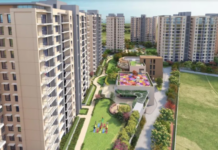New Delhi, July 10, 2016: The U.S. Green Building Council (USGBC) recently released its LEED in Motion: Industrial Facilities report, which highlights the collaborative efforts across the manufacturing sector to design and implement LEED (Leadership in Energy and Environmental Design) and prioritize environmental stewardship for industrial facilities.
Currently, there are more than 1,755 LEED-certified industrial facilities worldwide totaling more than 496 million square feet, and an additional 2,710 projects registered totaling nearly 737 millionsquare feet. This report showcases several of those LEED-certified industrial facilities.
With India expected to rank amongst the world’s top three economies with one of the top manufacturing destinations by 2020, sustainably built industrial facilities will be paramount to India’s long-term growth and global competitiveness.
“Sustainable industrial facilities impact a company’s triple bottom line – people, planet and profit,” said Rick Fedrizzi, CEO and founding chair, USGBC. “LEED helps manage business operations and creates a more sustainable, energy-efficient built environment that positively impacts worker health, reduces water and energy use and increases cost-savings while decreasing annual operating costs. The growing adoption of LEED in the industrial sector by both multinational corporations and local manufacturers has set a higher bar for leadership all around the world to work smarter and harder to leave a positive legacy.”
In recent years, India’s industrial base has emerged as one of the nation’s high growth sectors. The country’s leadership has set a goal of increasing manufacturing output to equal 25 percent of Gross Domestic Product by 2025, up from 16 percent today. This would translate into an economic contribution approaching 1 trillion USD and the creation of 90 million jobs.
Sustainable planning will be key to making this industrial build out highly efficient and profitable.
Industrial facilities, which include manufacturing buildings, warehouses, distribution centers and industrial campuses, operate on a vastly larger scale compared to homes, office buildings or even a university campus. Through LEED certification, the world’s most widely used green building rating program, industrial facilities can be designed, constructed and operated to be more resource efficient and high performing, which translates to increased value asset and millions of dollars in savings for owners and operators.
The manufacturing sector, which impacts every aspect of daily life, is essential to the global marketplace and a significant economic driver worldwide. With multinationals around the globe looking seriously at manufacturing in India, this report offers a unique perspective on the benefits of responding sustainably.
“Industrial facilities are important in the global marketplace and impact every facet of our daily lives. LEED certification leads to healthier, more productive industrial places, reduced stress on the environment, and savings for owners and occupants stemming from increased building value, higher lease rates and lower utility costs,” said Mahesh Ramanujam, COO, USGBC and President, GBCI, the third party body that certifies all LEED projects globally.
The LEED in Motion: Industrial Facilities report underscores how LEED is a transformative tool that positively impacts the quality of built space and can be applied to all building types. Because environmental, climate conditions, worker health and safety codes, standards, and laws vary, LEED developed a mechanism for recognizing those differences while still achieving the same credit intent and requirements. In developing the newest version of the rating system, LEED v4, the LEED Warehouse and Distribution Center adaption was designed to meet the specific needs of the global manufacturing sector and leads to high-performance in human and environmental health, sustainable site development, water savings, energy efficiency, materials selection, supply chain and indoor environmental quality.
Every day, more than 1.85 million square feet of space is LEED certified in more than 160 countries and territories. More than 78,600 commercial projects are currently participating in LEED, comprising more than 15 billion square feet of construction space. With specific achievement paths built in, LEED is designed for use in various building types in a variety of climates and localities, often synching with local laws and requirements.
LEED in Motion: Industrial Facilities is the latest in a series of reports from USGBC designed to provide a holistic snapshot of the green building movement in international markets. The report equips green building advocates with the insight and perspective to understand the use of the globally recognized LEED rating system and to make a strong case for sustainable building activity.
To read the full report, please click here.
Corporate Comm India (CCI Newswire)



















